theartsdesk in Florence: The Springtime of the Renaissance | reviews, news & interviews
theartsdesk in Florence: The Springtime of the Renaissance
theartsdesk in Florence: The Springtime of the Renaissance
A monumental display investigates the Florentine debt to antiquity
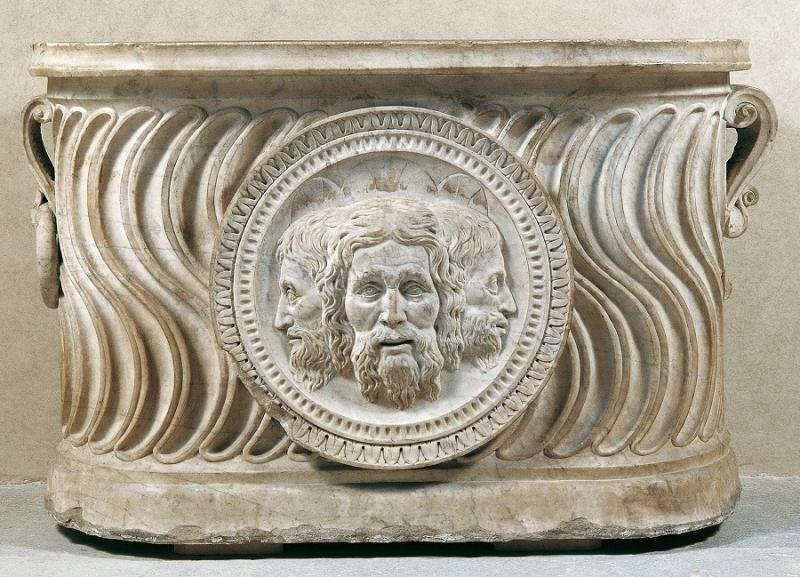
It’s an instinct of curators to put the pieces back together, to reintroduce works of art which time and market forces have scattered to the four winds. In recent memory, exhibitions have reunited in one space all of Monet’s haystacks, Cézanne’s card players and, in the case of the National Gallery’s momentous Leonardo show, both versions of The Virgin on the Rocks. A new exhibition opened this week in Florence which takes the business of synthesis to the next level.
The Florentine Renaissance – as implied by the name conferred on it by Burckhardt in The Civilization of the Renaissance in Italy (1860) – gestated in an antique womb. To put it highly reductively, the statuary and reliefs commissioned in the early decades of the 1400s in Florence were inspired by the rediscovery of classical form. The Springtime of the Renaissance goes in search of that relationship, the causal link between Quattrocento Florence and pre-Christian Rome (and by extension, beyond it ancient Greece).
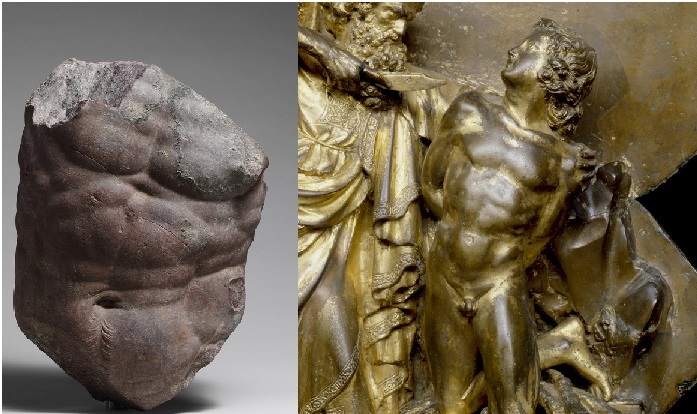 And what an overpowering spectacle it is. Occupying the first-floor gallery of the Palazzo Strozzi, it establishes in 10 rooms that what the city’s millions of casual visitors may think of as primarily a painterly movement – Botticelli’s Venus is the face of Florence on all the apps and aprons – was first carved in stone and cast in metal. Take the star exhibits of the first room. The accepted year zero of the Renaissance is 1401, when the competition to design the bronze doors of the Baptistery yielded two works which have been exhibited side by side more or less ever since. You can see perfectly serviceable copies of The Sacrifice of Isaac by Brunelleschi and Ghiberti in the V&A. What you can’t see are the hunks of classical marble from which the two young goldsmiths explicitly drew their inspiration. But here they both are: a Boy with Thorn from the first century BC whose bent-over pose is precisely echoed by one of Brunelleschi’s shepherds (see gallery), while the rippling trunk of Ghiberti’s Isaac quotes the twisted marble Torso of a Centaur (both pictured above) from the first century AD. The connection could not be clearer.
And what an overpowering spectacle it is. Occupying the first-floor gallery of the Palazzo Strozzi, it establishes in 10 rooms that what the city’s millions of casual visitors may think of as primarily a painterly movement – Botticelli’s Venus is the face of Florence on all the apps and aprons – was first carved in stone and cast in metal. Take the star exhibits of the first room. The accepted year zero of the Renaissance is 1401, when the competition to design the bronze doors of the Baptistery yielded two works which have been exhibited side by side more or less ever since. You can see perfectly serviceable copies of The Sacrifice of Isaac by Brunelleschi and Ghiberti in the V&A. What you can’t see are the hunks of classical marble from which the two young goldsmiths explicitly drew their inspiration. But here they both are: a Boy with Thorn from the first century BC whose bent-over pose is precisely echoed by one of Brunelleschi’s shepherds (see gallery), while the rippling trunk of Ghiberti’s Isaac quotes the twisted marble Torso of a Centaur (both pictured above) from the first century AD. The connection could not be clearer.
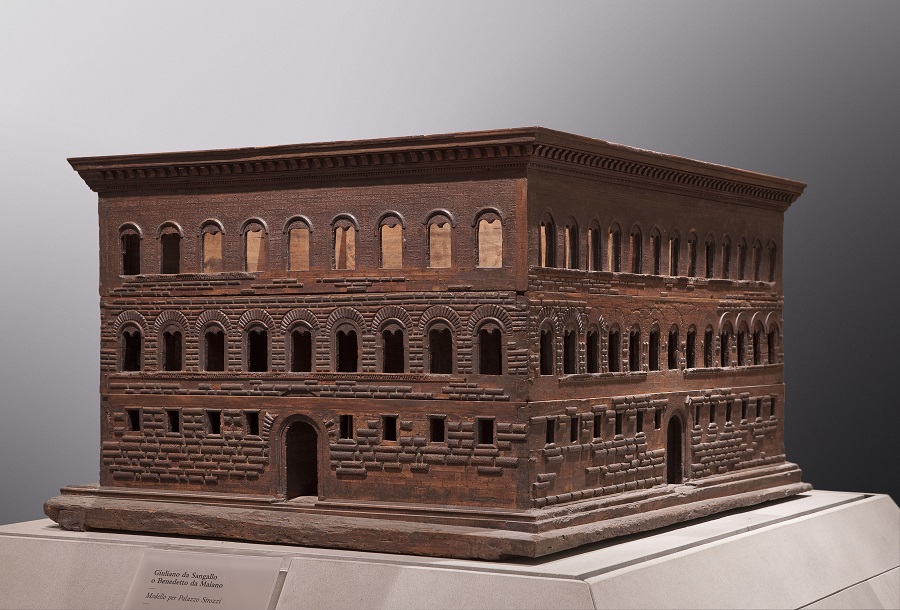 Nor could the skies over Florence on the day the exhibition is shown to the media. It feels naturally fitting that the first day of real spring greets The Springtime of the Renaissance. Above the open courtyard of the Palazzo Strozzi, a rectangle of blue looks down as the Italian press delegation strips the hospitality table like locusts. In a city which has few places to mount temporary exhibitions, in recent years the Strozzi has become an accommodating and, more to the point, enterprising host. (Pictured above, Model of Palazzo Strozzi, 1489)
Nor could the skies over Florence on the day the exhibition is shown to the media. It feels naturally fitting that the first day of real spring greets The Springtime of the Renaissance. Above the open courtyard of the Palazzo Strozzi, a rectangle of blue looks down as the Italian press delegation strips the hospitality table like locusts. In a city which has few places to mount temporary exhibitions, in recent years the Strozzi has become an accommodating and, more to the point, enterprising host. (Pictured above, Model of Palazzo Strozzi, 1489)
Its flamboyant Anglo-Canadian director James Bradburne is that considerable rarity, a foreigner at the helm of an Italian institution. Since landing the job in 2006 he has made it his task to reintroduce Florentines to their own city. Thus shows on Bronzino in 2010 and, last year, Botticelli made a virtue of the fact that, while not all of the relevant exhibits can be shipped in and put on display, many hang on nearby walls. For each exhibition the Strozzi publishes what it calls a passport – in reality a booklet with germane destinations in Florence and Tuscany. If the holder pays to see five sites in the passport, and gets the stamp to prove it, they get into the Strozzi show for free.
For no exhibition is the passport fuller than The Springtime of the Renaissance. Venues that can be visited include the recherché Horne and Bardini museums, both devoted to private collections of seductive bric-à-brac, as well as the Duomo’s excellent museum and the much-loved church of Santa Maria Novella, where Masaccio’s architectural fresco of the Trinity is very much part of the story. But the really key venue is the Bargello. Florence’s glorious sculpture museum is the co-curator of The Springtime in the Renaissance alongside the Louvre, where the show moves in September (it’s a measure how organically Florentine this exhibition is that, for the first time in its history, the world’s greatest museum has consented to go second).
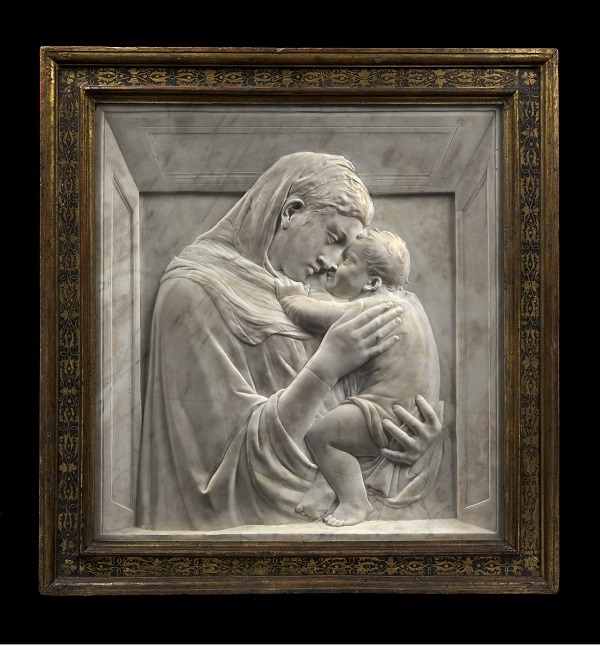 Both museums are heavily represented at the Strozzi, alongside pieces from all over the world, some restored for the event, one or two never seen in public before, several reintroduced to one another after centuries apart. One of the most pleasing results is the return to his home city of the Florentine doctor Chellini, the subject of Antonio Rossellino’s portrait bust, wattled neck frothing under a forthright chin. He crops up again as the recipient of the Chellini Madonna, an exquisite bronze roundel with which Donatello settled a medical bill. Marc Bomand, the wafer-thin, moustachioed curator-in-chief of the Département des Sculptures at the Louvre, reports that requests for loans had an unprecedented strike rate of 90 percent. (The regular figure is closer to 50.)
Both museums are heavily represented at the Strozzi, alongside pieces from all over the world, some restored for the event, one or two never seen in public before, several reintroduced to one another after centuries apart. One of the most pleasing results is the return to his home city of the Florentine doctor Chellini, the subject of Antonio Rossellino’s portrait bust, wattled neck frothing under a forthright chin. He crops up again as the recipient of the Chellini Madonna, an exquisite bronze roundel with which Donatello settled a medical bill. Marc Bomand, the wafer-thin, moustachioed curator-in-chief of the Département des Sculptures at the Louvre, reports that requests for loans had an unprecedented strike rate of 90 percent. (The regular figure is closer to 50.)
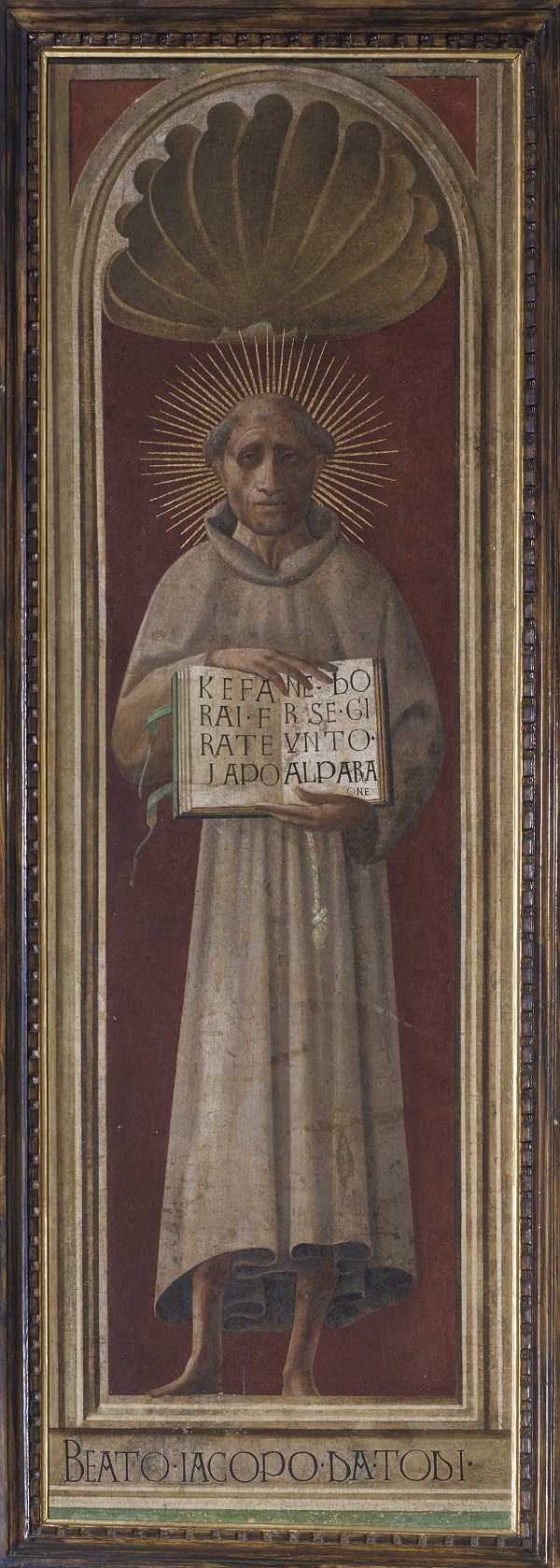 The result is a quite staggering anthology. It begins, in fact, in the port city of Pisa. In the 13th century Florence’s historic rival was a melting pot of influences arriving from far and wide. In the process of creating the Baptistery font for the Campo dei Miracoli (home also to a certain listing campanile), the sculptor Nicola Pisano was first among many to fall under the inspiring spell in particular of the Talento Crater, a first-century Roman urn with Bacchic bas-reliefs which happened to be sitting around in Pisa. Placing it squarely at the entrance to the exhibition, the curators argue that this is very much Exhibit A in the story of the Renaissance.
The result is a quite staggering anthology. It begins, in fact, in the port city of Pisa. In the 13th century Florence’s historic rival was a melting pot of influences arriving from far and wide. In the process of creating the Baptistery font for the Campo dei Miracoli (home also to a certain listing campanile), the sculptor Nicola Pisano was first among many to fall under the inspiring spell in particular of the Talento Crater, a first-century Roman urn with Bacchic bas-reliefs which happened to be sitting around in Pisa. Placing it squarely at the entrance to the exhibition, the curators argue that this is very much Exhibit A in the story of the Renaissance.
The plot continues through rooms which each explore different aspects of Florence’s cultural rebirth. One investigates the fusion of Christian imagery with the values of Republican Rome, as exemplified by the Altar Frontal attributed to Portigiani and Michelozzo. In this startling oxymoron, a manifestly classical sarcophagus plays host to an image of the holy trinity (main image). Another room is devoted to imagery of putti, those tubby little infants via which pagan and religious symbolism innocently merged. The rise of the condottiere and the equestrian statue are considered, as is the spread of sculptural forms into painting (pictured above right, Paolo Uccello's Jacopone da Todi, c 1433-4). One room sums up in a handful of pieces the Florentine discovery of the vanishing point. As the story lengthens into the second half of the 15th century, civic wealth finds public works making way for private commissions – frank bust portraits by Mino da Fiesole and Desiderio da Settignano, and ravishing altarpieces which could be cheaply reproduced using the new technique of glazed terracotta developed by Luca della Robbia (pictured below, the Genoa Madonna, 1445–50).
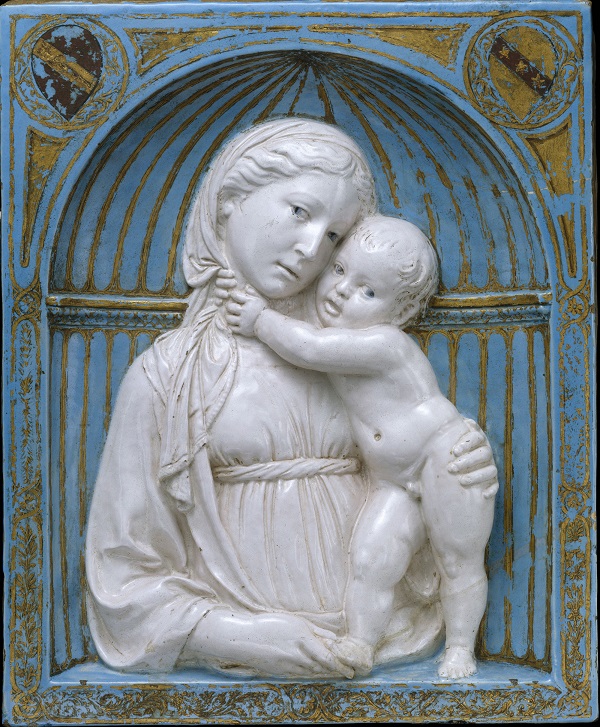 A catalogue produced for the exhibition feels like the only introduction to the Renaissance you will ever need. Weighing in at 4kg, its heaviness is sometimes mirrored in ponderous, latinate prose translated from Italian. But among many excellent essays, the book makes the important point that Brunelleschi’s loss in the competition to design the bronze doors was posterity’s gain. Ghiberti would not finish the job for 22 years, leaving his rival free to design the self-supporting dome of the cathedral that remains the city’s miraculous symbol (and, even before its completion, a frequent feature of this exhibition).
A catalogue produced for the exhibition feels like the only introduction to the Renaissance you will ever need. Weighing in at 4kg, its heaviness is sometimes mirrored in ponderous, latinate prose translated from Italian. But among many excellent essays, the book makes the important point that Brunelleschi’s loss in the competition to design the bronze doors was posterity’s gain. Ghiberti would not finish the job for 22 years, leaving his rival free to design the self-supporting dome of the cathedral that remains the city’s miraculous symbol (and, even before its completion, a frequent feature of this exhibition).
The longest shadow cast over The Springtime of the Renaissance is not by either of the above, but another sculptor whom posterity sometimes seems to take for granted. If ever there were an advertisement for the wide-ranging and deeply connected genius of Donatello it is here in his beautiful Madonnas (pictured top, Pazzi Madonna, 1420-5), his monumental saints, his fleshy candle-wielding putti, his epic horse’s head for the unfinished Monument to Alfonso V of Aragon. It is as if there is nothing he cannot do. His Herod’s Banquet is an airy riff on the tradition of the thickly crowded Roman bas-relief. Making use of a depth of only a few millimetres, he contrives to populate the scene not just with the dancing Salome and the Baptist’s head on a salver but figures massing in the background, mere ghosts and faint rumours summoned into clarity by the hand of a master.
None of these nuances will be lost on visitors to Palazzo Strozzi, an exhibition venue which has introduced a mini-revolution of its own: tablet-sized user-friendly labels that do not require visitors to cluster like bees round a honey pot - or media round a hospitality table. The result is a show whose totality thrills on every conceivable level: intellectually, aesthetically and, above all, emotionally. Get your passport.
For more images visit our The Springtime of the Renaissance gallery
- The Springtime of the Renaissance: Sculpture and the Arts in Florence, 1400-1600 at the Palazzo Strozzi until 18 August, then at Musée du Louvre from 26 September to 6 January 2014
Page 1
Classical Roman art, Torso of a Centaur, 1st century AD, rosso antico marble. Metropolitan Museum of Art, New York. © 2012. Metropolitan Museum of Art/Art Resource/Scala, Firenze
Lorenzo Ghiberti: The Sacrifice of Isaac, 1401, partly gilt bronze. Museo Nazionale del Bargello, Florence. Photograph by Antonio Quattrone. By permission of Ministero per i Beni e le Attività Culturali
Model of Palazzo Strozzi, 1489, by Giuliano da Sangallo or Benedetto da Maiano, carved wood, Museo Nazionale del Bargello, Florence. Photograph by Lorenzo Mennonna. By permission of Ministero per i Beni e le Attività Culturali
Page 2
Donatello, Madonna and Child (Pazzi Madonna), c. 1420–5, marble. Bode-Museum, Staatliche Museen zu Berlin.
Paolo Uccello, Jacopone da Todi, c. 1433–4, detached fresco. Museo dell’Opera del Duomo, Prato. Fototeca Ufficio Beni Culturali Diocesi di Prato
Luca della Robbia, Madonna and Child, 1450–60, glazed and gilded terracotta. Metropolitan Museum of Art, New York. © 2012. Metropolitan Museum of Art/Art Resource/Scala, Firenze
Explore topics
Share this article
Add comment
The future of Arts Journalism
You can stop theartsdesk.com closing!
We urgently need financing to survive. Our fundraising drive has thus far raised £49,000 but we need to reach £100,000 or we will be forced to close. Please contribute here: https://gofund.me/c3f6033d
And if you can forward this information to anyone who might assist, we’d be grateful.

Subscribe to theartsdesk.com
Thank you for continuing to read our work on theartsdesk.com. For unlimited access to every article in its entirety, including our archive of more than 15,000 pieces, we're asking for £5 per month or £40 per year. We feel it's a very good deal, and hope you do too.
To take a subscription now simply click here.
And if you're looking for that extra gift for a friend or family member, why not treat them to a theartsdesk.com gift subscription?
more Visual arts
 'We are bowled over!' Thank you for your messages of love and support
Much-appreciated words of commendation from readers and the cultural community
'We are bowled over!' Thank you for your messages of love and support
Much-appreciated words of commendation from readers and the cultural community
 Photo Oxford 2025 review - photography all over the town
At last, a UK festival that takes photography seriously
Photo Oxford 2025 review - photography all over the town
At last, a UK festival that takes photography seriously
![SEX MONEY RACE RELIGION [2016] by Gilbert and George. Installation shot of Gilbert & George 21ST CENTURY PICTURES Hayward Gallery](https://theartsdesk.com/sites/default/files/styles/thumbnail/public/mastimages/Gilbert%20%26%20George_%2021ST%20CENTURY%20PICTURES.%20SEX%20MONEY%20RACE%20RELIGION%20%5B2016%5D.%20Photo_%20Mark%20Blower.%20Courtesy%20of%20the%20Gilbert%20%26%20George%20and%20the%20Hayward%20Gallery._0.jpg?itok=7tVsLyR-) Gilbert & George, 21st Century Pictures, Hayward Gallery review - brash, bright and not so beautiful
The couple's coloured photomontages shout louder than ever, causing sensory overload
Gilbert & George, 21st Century Pictures, Hayward Gallery review - brash, bright and not so beautiful
The couple's coloured photomontages shout louder than ever, causing sensory overload
 Lee Miller, Tate Britain review - an extraordinary career that remains an enigma
Fashion photographer, artist or war reporter; will the real Lee Miller please step forward?
Lee Miller, Tate Britain review - an extraordinary career that remains an enigma
Fashion photographer, artist or war reporter; will the real Lee Miller please step forward?
 Kerry James Marshall: The Histories, Royal Academy review - a triumphant celebration of blackness
Room after room of glorious paintings
Kerry James Marshall: The Histories, Royal Academy review - a triumphant celebration of blackness
Room after room of glorious paintings
 Folkestone Triennial 2025 - landscape, seascape, art lovers' escape
Locally rooted festival brings home many but not all global concerns
Folkestone Triennial 2025 - landscape, seascape, art lovers' escape
Locally rooted festival brings home many but not all global concerns
 Sir Brian Clarke (1953-2025) - a personal tribute
Remembering an artist with a gift for the transcendent
Sir Brian Clarke (1953-2025) - a personal tribute
Remembering an artist with a gift for the transcendent
 Emily Kam Kngwarray, Tate Modern review - glimpses of another world
Pictures that are an affirmation of belonging
Emily Kam Kngwarray, Tate Modern review - glimpses of another world
Pictures that are an affirmation of belonging
 Kiefer / Van Gogh, Royal Academy review - a pairing of opposites
Small scale intensity meets large scale melodrama
Kiefer / Van Gogh, Royal Academy review - a pairing of opposites
Small scale intensity meets large scale melodrama
 Jenny Saville: The Anatomy of Painting, National Portrait Gallery review - a protégé losing her way
A brilliant painter in search of a worthwhile subject
Jenny Saville: The Anatomy of Painting, National Portrait Gallery review - a protégé losing her way
A brilliant painter in search of a worthwhile subject
 Abstract Erotic, Courtauld Gallery review - sculpture that is sensuous, funny and subversive
Testing the boundaries of good taste, and winning
Abstract Erotic, Courtauld Gallery review - sculpture that is sensuous, funny and subversive
Testing the boundaries of good taste, and winning
 Edward Burra, Tate Britain review - watercolour made mainstream
Social satire with a nasty bite
Edward Burra, Tate Britain review - watercolour made mainstream
Social satire with a nasty bite

Comments
By coincidence, "Revealing